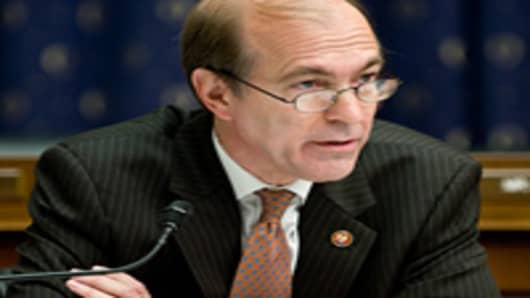A little-noticed bill introduced in the House last March may be the first step in connecting financial reform efforts with the eventual attempt to restructure the nation's housing financial system and the deeply troubled Fannie Mae and Freddie Mac .
The U.S. Covered Bonds Act, introduced by Scott Garrett (R-NJ) and co-sponsored by Spencer Bachus (R-Ala.) and Paul Kanjorski (D-Pa.) and others, would add liquidity to the still sluggish credit markets and offer a private-market mortgage lending alternative to the government loans and guarantees of the two firms, which were taken over by the Treasury in September 2008 as the financial crisis was about to explode.
Garrett failed to get the measure included in the either the House or Senate versions of the financial reform bill, but there's some speculation it could wind up in the compromise bill that will will be crafted in the coming weeks by a House-Senate conference committee, of which Garrett could be a member.
"We're certainly going to certainly push it," Garrett told CNBC.com in an interview Tuesday. "We always saw it as a slice of the reform process. It's one of the few pieces that will do what the markets' need--provide certainty. It's not a total solution, but a piece of the puzzle."
The proposal is also likely to come up when the House subcommittee on capital markets—whose senior members are Kanjorski and Garrett—takes up the issue of the government-supported housing market with Edward J. DeMarco, acting director of the Federal Housing Finance Agency, at a hearing Wednesday.
The proposal hopes to free up mortgage lending through the use of so-called covered bonds—debt securities that are backed by the cash flow of a loan such as a mortgage. The loan is secured—or covered—by a pool of assets that investors can claim rights to if the issuer, or originator, becomes insolvent.
Though covered bonds are common in European countries, they are relatively rare in the U.S. Bank of America and the old Washington Mutual, now a unit of JPMorgan Chase , have issued them and firms like BlackRock and Pimco invested in them. But proponents in the US argue that covered bonds need a solid legal framework with clear rights of onwership to create and drive a healthy, dynamic marketplace.
The push for covered bonds is not new, but the timing is probably better.
In mid 2008, with Fannie and Freddie clearly in trouble, Treasury Secretary Henry Paulson lined up four large US banks to kick-start a covered-bond market, largely as an alternative to mortgage-backed securities. The mortgage market meltdown and broader financial crisis snuffed out the effort.
Today, it's exactly that MBS alternative that's makes covered bonds so relevant, especially since the Obama administraion and Congress opted to keep any overhaul of the two mortgage giants and the mortgage finance system out of the regulatory reform bill. Legislation won't happen until 2011 at the earliest.
"There's not a lot of certaintly about how the GSE debate will evolve and play out," says one market player, referring to Fannie and Freddie's special status as government sponsored enterprises. "The securitization business is obviously still struggling. You need more tools, It's better you have the options."
Proponents point to the dark early days of the financial criss when the government's plan to buy toxic assets from a market with little or transparency was dropped.




